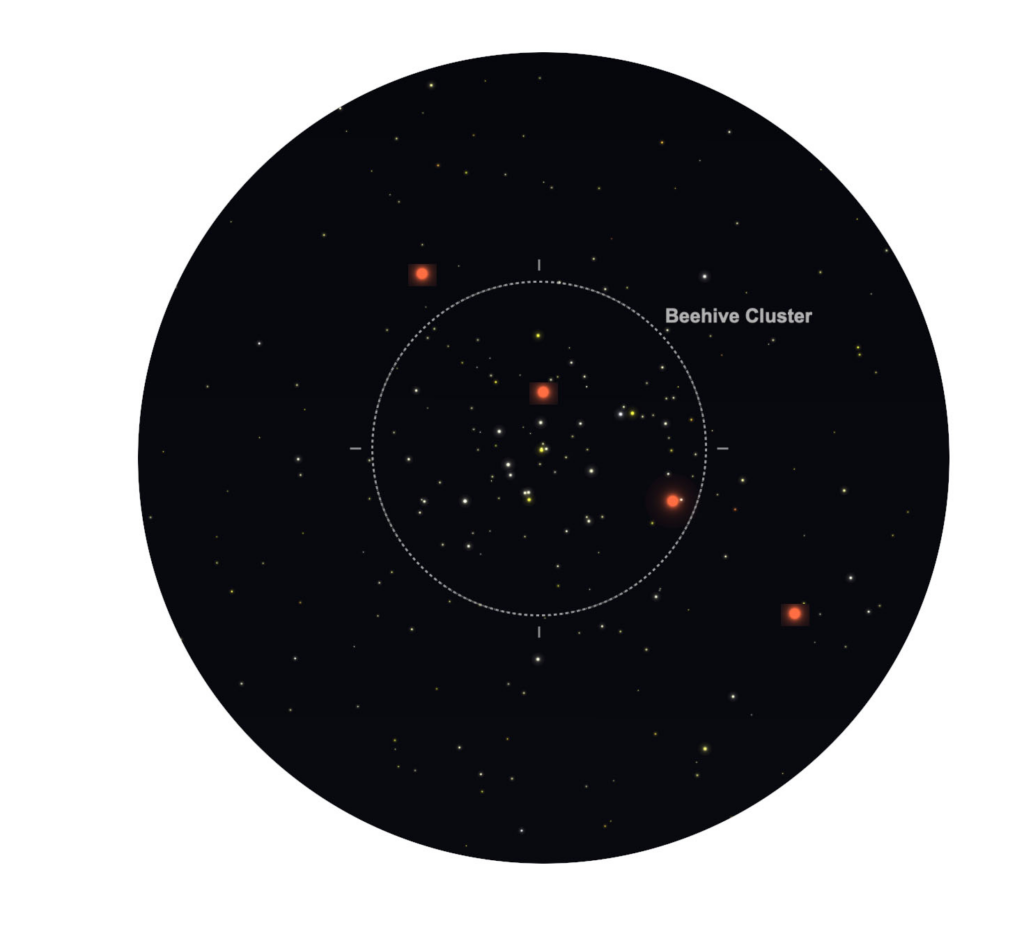Sky Report: May 29 – June 4, 2023

Mars passes in front of the stars of the Beehive Star Cluster on the nights of June 1 and 2. The graphic shows Mars nightly from May 31 at lower right through June 3 at upper left. The view is 3° wide. Look once it is fully dark about 90 min after sunset; Mars will then be 1/3 of the way up the western sky. Graphic created with SkySafariAstronomy.com.
Turning first to planets, Mars and Venus form a pretty pair in the evening sky. They’re only 11° apart – the width of your fist held at arm’s length — but they’re very unmatched in brightness. Venus is the brightest thing in the night sky (other than the moon) but Mars is only 1/150 as bright! That still puts Mars as bright as the brighter stars. You’ll see Venus 1/3 of the way up the western sky as darkness falls, and Mars is to the upper left of Venus. Note the color contrast.
Venus has been moving eastward against the background of stars for months, approaching Mars, which has been moving eastward too but at half the speed. Watch Venus continue to close the gap.
Venus is in Gemini, and on the night of June 1 it’s in line with the heads of the Twins; Pollux is on the left and Castor on the right. The three span 10°. By watching Venus go into and then out of alignment you can easily monitor its nightly motion.
The unusual event of the week is the passage of Mars in front of the bright star cluster M44, familiarly known as the Beehive (appropriate for Utah), in the constellation Cancer. M44 is bright enough to have been known since ancient times; it was described as “a little mist” in 260 B.C. In 1609 Galileo discovered its true nature when he saw it as a cluster of more than 40 stars; we suspect there are at least 1,000. They’re a relatively close (for a star cluster) 577 light years from earth and the stars are a youthful 600-750 million years old. Google can tell you more.
That said, Mars cuts across, or transits, the northern edge of the cluster on the nights of the 1st and 2nd. The cluster is easily visible to the unaided eye if the sky is dark but binoculars are much better and a spotting telescope is best. Track Mars as it approaches, transits, and then leaves the Beehive Cluster behind, all in a few days.
Saturn is well up in the morning. An hour before sunrise it’s due southeast (azimuth = 90°) and precisely 1/3 of the way up the sky. Saturn isn’t overwhelmingly bright but it’s by far the brightest star-like thing in the constellation Aquarius so you’ll have no trouble picking it out. The similarly bright star below and to the right of it is Fomalhaut in Pisces Austrinus.
Also an hour before sunrise Jupiter is visible with difficulty, despite its brightness, because it is so low (altitude = 10°) in the east. It’ll be higher this summer.
On the 29th Mercury is as far from the sun as it gets (“greatest western elongation” to use the technical term) in the morning sky but it will be difficult to see as was explained with a graphic in my Sky Report for April 10-16 (they’re archived at https://stellarvistaobservatory.org/category/sky-reports/. Wait for its September evening appearance.
Stellar Vista Observatory provides portable telescopes and tripod mounted binocular kits on loan for free to residents and visitors in Kane County. Enhance your enjoyment of the night sky! To learn more, request a loan, or attend one of SVO’s free public star parties for 2023, visit https://stellarvistaobservatory.org/ or drop in to the Kane County Office of Tourism.






Comments are closed.